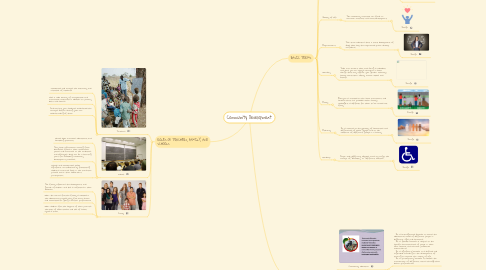
1. ROLES OF TEACHERS, FAMILY, AND SCHOOLS
1.1. Teachers
1.1.1. Stimulates and accepts the autonomy and initiative of students
1.1.2. Uses a wide variety of manipulative and interactive materials in addition to primary data and sources
1.1.3. Find out how your students understood the concepts before sharing your own understanding of them
1.2. Schools
1.2.1. Schools have enormous educational and socializing potential.
1.2.2. They have information (coming from discourses found in their classrooms, patios and scenarios) on the conditions and lifestyles, which can be a starting point for mobilizing community development processes.
1.2.3. Schools and communities make significant contributions by facilitating children's contacts, both in the transition process and in their subsequent participation.
1.3. Family
1.3.1. The family influences the development and growth of children and this is reflected in their behavior.
1.3.2. When the minors feel the family is involved in the educational process, they feel more secure and committed to giving a better performance.
1.3.3. When children feel the support of their parents, the level of absenteeism and loss of school cycles is lower.
2. BASIC TERMS
2.1. Inhabitant commitment
2.1.1. The active and constant support of citizens has a significant level of association and appeasement.
2.1.1.1. Image
2.2. Secure Human Rights
2.2.1. The Universal Declaration of Human Rights should guide our work with communities and community development workers.
2.2.1.1. Image
2.3. Quality of life
2.3.1. The community initiative can focus on economic, material, and social development.
2.3.1.1. Image
2.4. Empowerment
2.4.1. This term indicates that a total development of skills that help the empowered person develop confidence.
2.4.1.1. Image
2.5. Diversity
2.5.1. Take into account that each being is individual and that you can always intervene in some change that may affect your gender, ethnicity, sexual orientation, ability, income, values and beliefs.
2.5.1.1. Image
2.6. Equity
2.6.1. Everyone is entitled to the same treatment and services that are provided within society, although it is difficult for them to be carried out fairly.
2.6.1.1. Image
2.7. Ethnicity
2.7.1. It is related to the plurality of similarities and differences of these groups, and to the existence of different groups in a society.
2.7.1.1. Image
2.8. Handicap
2.8.1. People with different abilities tend to prefer the concept of “disability” or “different abilities”.
2.8.1.1. Image
3. CONCEPTS AND ELEMENTS
3.1. Community education
3.1.1. - It is heterogeneous because it meets the educational needs of different people, in different ages and situations. - It is flexible because it adapts to the specific characteristics of people in their socio-cultural and economic-productive environments. - It is significant because it is defined and organized according to the development of learning to improve the quality of life. - It is participatory because it involves the intervention of different actors through their human performances.
3.2. Learning communities
3.2.1. * Promote values. In the learning community there are people of diverse origins and cultures, which is why values such as equality, respect, tolerance or peace are promoted. * Dialogue democratically. Everyone in the learning community can speak and will be heard. * Commit to the project. It provides a sense of belonging that facilitates work and favors interaction and dialogue. * Improve performance. In a learning community you work as a team, which helps to improve the performance of the participants.
